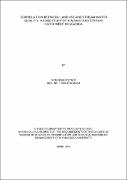Correlation between land use and stream water quality: a case study of Kinawataka stream catchment in Uganda
Abstract
Kinawataka wetland is an important ecosystem that plays a vital role in pollution and flood control as well as maintaining ground water supplies and quality in the Lake Victoria Basin. However, this wetland has undergone severe ecological degradation in the form of intensified industrial pollution, agriculture and climatic change. The main objective of this study was to determine the effect that land use activities in the Kinawataka stream catchment had on the stream water quality. The land use activities/cover in the stream catchment were determined by analysing 2018 Landsat images using supervised classification. To evaluate the stream water quality, pH, EC, TDS, TSS, Cl-, SO42-, BOD, COD, NO2-, NO3-, NH3, TN, TP, Total coliforms and faecal coliforms were analysed using standard methods. The effect of land use activity on the stream water quality analysed by using Spearman’s Correlation and Principal Component Regression.
The study revealed that the various land use (cover) activities were categorized into five (5) major land use characteristics which in order of coverage included; Built-up Area (40.51%) as the largest, Grassland (18.89%), Plantations (Agric.) (18.76%), Bare Soil (15.61%), and finally Tree Cover (6.22%) with the least area. The mean overall concentration of most the water quality parameters remained within their permissible NEMA effluent ranges except for TSS (478.03±1271 mg/L), EC (418.70± 68.22 μS/cm) and faecal coliforms (306.6±214.76 cfu/ 100ml) that exceeded the set guidelines. Bare Soil had a negative influence on the water quality as it increased with both the TSS (rho = 0.357) and faecal coliforms (rho = 0.355) at p<0.05. Built-up Area had a negative influence on the water quality as it increased with SO42- (rho = 0.506), NH3 (rho = 0.410) and faecal coliforms (rh0 = 0.441) at p<0.05. Grassland had a negative influence on the water quality as it increased with NH3 (rho = 0.370) and NO3- (rho = 0.389) at p<0.05. Plantations (Agric.) had a negative influence on the water quality as it increased with NO3- (rho = 0.370) at p<0.05. Tree Cover had a positive increase influence on the water quality as it decreased with the increase in pH (rho = -0.524), EC (rho = -0.572), BOD (rho = -0.386) and Cl- (rho = -0.376) at p<0.05. The principal component regression revealed that an increase in land cover with a combination of Grassland, Plantations and Built-up area (PC1) resulted in increased pH, EC, COD and NH3 concentration in the stream. Areas with a thin tree cover and large areas of exposed ground (PC2) resulted in increased TDS, Cl-, NH3 and NO2- levels of the stream. Those areas covered by bare soil, marram roads, garbage dump stations (PC3) resulted in increased TDS concentrations of the stream. Therefore, it could
be concluded that with the exception of tree cover, the rest of the land use activities in the stream catchment deteriorated the stream’s water quality.

